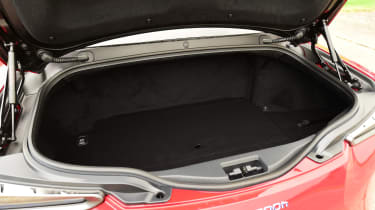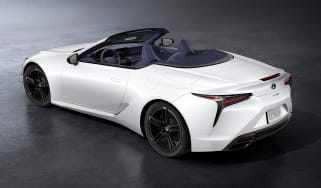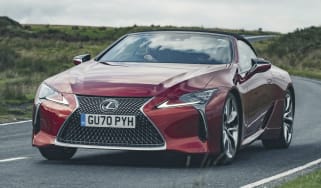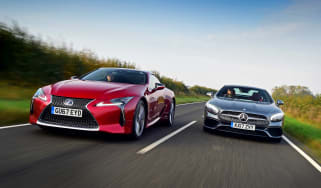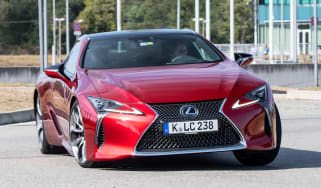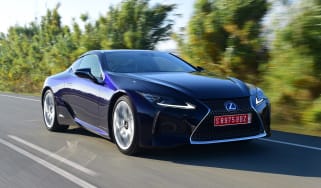Lexus LC (2017-2024) review
Hi-tech Lexus luxury coupe piles on the style to take on the Mercedes SL and BMW 8 Series

Lexus has never shied away from a challenge, pitching itself against the big German premium marques right across its model range. Now it’s taking on big coupes like the Mercedes SL and BMW 8 Series with the LC – and it does it rather well.
We love the hi-tech approach to making a hybrid powertrain and CVT gearbox work smoothly, while the V8 engine is a joy to drive hard, but it does need revs to really deliver.
The handling is pretty impressive, too, with plenty of grip and poise, even if the steering lacks a Porsche 911’s precision, which is what the engineers were aiming for. There’s also a fair amount of comfort and refinement when cruising, confirming the LC’s credentials as a grand tourer - indeed, Lexus has been at pains to say that the LC is 'absolutely not a sports car'.
As in all Lexus models, the quality is outstanding – inside and out – but, at the same time, the cabin is a mess of buttons and controls, while the Remote Touch infotainment controller is way behind rivals’ systems for usability.
This also isn’t a particularly practical GT – even calling it a 2+2 would be stretching it a bit, as the rear seats are best used for putting bags on, especially as the boot isn’t exactly cavernous.
Used - available now

2025 Volvo
XC90
56,482 milesAutomaticPetrol2.0L
Cash £30,997
2023 Volkswagen
Tiguan
33,623 milesAutomaticPetrol1.5L
Cash £24,976
2023 Tesla
Model Y
41,540 milesAutomaticElectric
Cash £23,676
2024 BMW
iX3
72,718 milesAutomaticElectric
Cash £22,197But as a complete package, Lexus has made a compelling alternative to the established German GTs.
While the market for luxury grand tourers is small, that hasn't stopped Lexus putting the LC on sale. This Japanese GT majors on style and technology, as it features the company's distinctive design cues, as well as its latest hybrid engineering and luxury equipment in the cabin.
There are two versions of the Lexus LC on sale: the LC 500 and LC 500h. Both feature a traditional front engine, rear-wheel-drive layout, with the LC 500 coming with a 5.0-litre V8 petrol engine, and the LC 500h fitted with a 3.5-litre V6 petrol engine combined with an electric motor and battery pack. Inside, the LC has a 2+2 seating layout, with a spacious front cabin and only occasional seats in the back.
Under the skin, the LC was the first model to benefit from a new rear-drive platform that also forms the basis of the Lexus LS limousine, plus the replacement for the GS, the ES executive saloon, as well as the next IS compact saloon.
Prices start from around £76,500, and the V8 and hybrid models cost the same, so you can choose between power or efficiency. The V8 model is less advanced than the hybrid, although it still features a trick 10-speed auto gearbox. The 500h features this gearbox as well as a CVT box. This keeps the revs at a constant point, whether for maximum performance or optimum efficiency, while the 10-speeder is essentially a conventional four-speed auto that changes its output in stages to provide a wider spread of usable torque.
At full throttle, the CVT box is in use, but in normal driving, the 'regular' auto makes the LC feel more natural to drive than a CVT-equipped car. This arrangement all but eliminates the 'rubber band' feeling of traditional CVTs, while being quick to change and enhancing the performance of the car: the hybrid is only 0.3 seconds off the V8’s 4.7-second 0-62mph time.
As the LC is a halo model (in some ways it's a higher volume replacement for the LFA supercar), it's very well equipped, with a 12-speaker stereo, sat-nav, rear camera, 20-inch wheels, LED headlights, a glass roof, 10-way adjustable climate seats in leather and adaptive suspension all included. There's lots of safety kit, too, including blind spot monitor with rear traffic alert and Lexus' Safety System+ package.
On top of this, you can add Sport or Sport+ packs, with the former adding Alcantara and leather sports seats, 21-inch wheels and a carbon fibre roof - Sport+ adds rear-wheel steering, a limited slip diff, retractable rear spoiler and carbon fibre scuff plates. Finally, the Limited Edition model has a Mark Levinson stereo and a colour head-up display. This model is the most expensive version available, weighing in at around £92,000.
The market for large luxury coupes is smaller than most, and the LC's only real rivals at a similar price are the BMW 8 Series and ageing Maserati GranTurismo. The Mercedes SL can be counted as a rival with a folding hard top, but it's only a two-seater, while cars such as the Mercedes S-Class Coupe, Aston Martin DB11 and Ferrari Portofino are quite pricey 2+2s in comparison. Other models worth considering, but which have a sportier edge, are the Porsche 911 and Jaguar F-Type, although again the latter is a two-seater only.
Engines, performance and drive
All models grip well and turn in sharply, even though the steering lacks a little in feel. However, Sport+ models with their limited slip differential and rear-wheel steering add a degree of sharpness and agility that make this big coupe feel far more nimble than you’d expect from a car of this size and weight.
Importantly, it's predictable and the LC’s balance is safe – although the chassis can be coaxed into indulging in some welcome sporty behaviour.The LC is great for refinement, and the ride is supple enough. The CVT can frustrate your driving enjoyment, but at a more sedate pace it’s acceptable. A little more electric-only range would be welcome, though.
Even on optional 21-inch wheels as part of the £9,300 Sport Plus pack, the LC rides nicely, while the Sport Plus model’s rear-wheel steering means that, despite the long wheelbase, the LC changes direction quickly, even if there’s not much feedback through the lifeless set-up.
Importantly, it is predictable, and combined with a limited-slip differential, the LC’s balance is safe – but the chassis can be coaxed into indulging in some welcome sporty behaviour. The LC features six drive modes: Comfort, Eco, Normal, Custom, Sport and Sport+. This is too many. Three would do, because the difference between these settings really isn’t that great.
Engines
Your Lexus LC can come in two flavours – a more traditional 5.0-litre V8 with 471bhp and a clever 3.5-litre V6 hybrid with 354bhp. Yet, in spite of the difference in power, the V6 is only 0.3secs slower from 0-60mph, taking 5.0secs compared with the V8’s time of 4.7secs.
The V8 has by far the most in-gear oomph, though, and its traditional automatic gearbox with a multi-plate clutch snaps through the gearchanges, especially with the car in Sport or Sport+ mode. Those used to the punchiest turbo engines will find the naturally-aspirated unit a little flat at first, but there are real thrills and strong acceleration available if you’re prepared to use all the revs.
It sounds great, too, as a tube from the engine to the cabin transfers the V8’s more pleasant frequencies through under hard acceleration. Valves in the exhaust system open according to your driving style, and release a glorious noise, with a bonus crackle on full-throttle gearchanges.
The V6 hybrid uses a clever CVT gearbox with a four-speed auto attached to it. With three engineered CVT steps for every one of the first three gears in the standard auto, plus the fourth being an overdrive, you effectively get a ten-speed 'box.
It’s been designed to eliminate the ‘rubber band’ feel of CVTs and by-and-large does the job. However, it’s still not entirely natural, with a slight delay when the box can’t help but hold the revs at the most efficient engine point for a moment longer than a normal auto would.
That said, the hybrid still offers a decent level of performance and an enjoyable V6 sound, but with the added bonus of improved fuel consumption and lower emissions.
If there is a downside, it's that the hybrid's electric motor works in reverse as a generator to help recharge the battery when braking, which means pedal feel is distant and doesn’t inspire confidence when pressing on. It also makes it harder to bring the car to a smooth stop in town, which is a small annoyance, given the LC’s remit as a comfortable GT.
MPG, CO2 and Running Costs
Given how much performance it has, the hybrid puts up a reasonable performance for economy. In the official tests, its combined fuel economy is 44.1mpg, while it emits just 145g/km of CO2 - impressive.
It's especially impressive when you compare that with the V8, which is not much quicker, but manages only just over half of the hybrid's economy. And, of course, if you use its full potential, you won't be able to get anywhere near the 24.6mph it returns in the official tests.
Perhaps unsurprisingly, these won’t be cheap cars to buy or to run – every model is in at least Group 47 for insurance – but at least you shouldn’t get any unexpected bills in the long run if the brand’s reliability record is anything to go by. Lexus continually sits at the top of our Driver Power satisfaction survey, with strong reliability scores contributing to the strong performances.
Interior, design and technology
There’s a throwback to the Lexus LFA supercar inside the LC. The large dial in the centre of the instrument binnacle will slide sideways to reveal another screen that controls some of the vehicle settings and provides more driving data. It’s a neat touch and a bit of showmanship, but sadly the rest of the interior is something of a mixed bag.
On the positive side, real craftsmanship is evident throughout the cabin, and nowhere more so than on the sweeping door panels, with what appears like a floating aluminium handle – a minimalist delight.
Sadly, though, the dash and steering wheel are an ergonomic mess, with buttons littered about like popcorn on a cinema floor. For example, you’ll either leave the lane departure warning on or, more likely, off – so why stick a button controlling it on the steering wheel?
And the horns sticking out of the instrument binnacle with controls for the driving modes on one side and the traction control on the other look like the designers forgot to include a few more buttons elsewhere. Lexus would do well to benchmark BMW’s iDrive system for vehicle and infotainment controls.
That said, the quality is exceptional, and the seats are really comfy, whether you go for luxury spec, with material that flows over the seat shoulders like Superman’s cape, or the grippier seats in Sport and Sport+ models.
And, whichever model you choose, there’ll be plenty of technology on board to make life easier and to pamper you – as you’d expect in a luxury GT.
Sat-nav, stereo and infotainment
Audiophiles have long headed to Lexus for a great in-car experience, and the LC should be no different, with the 13-speaker system from high-end hi-fi specialists Mark Levinson. The system has been specially tuned for the LC and is the first to feature Clari-Fi – technology that boosts compressed audio files like those stored on smartphones almost back to their uncompressed state.
If you don’t opt for the Mark Levinson system (which is standard on the Limited Edition model, and optional on the rest of the range), there’s a bespoke Pioneer surround sound system for you to feast your ears on.
Although you don’t get Apple CarPlay or Android Auto, there’s still lots of functionality and a large 10.3-inch screen. But the Lexus’s infotainment is infuriating. The touchpad is one of the worst on the market; it’s borderline unusable on the move and has far too many steps for each action. Other systems, notably BMW’s iDrive, do it much better.
Practicality, comfort and boot space
Dimensions and size
At 4770mm long and 1920mm wide, the LC isn’t a small car. Yet, not much of that seems to be translated to room inside the cabin.
Leg room, head room & passenger space
Although the LC is billed as a 2+2, in practice it’s far better to think of it as a two-seater and treat the two rear seats as nothing more than extended luggage space. Because it's so cramped back there, you’ll struggle to get anyone in the rear seats unless the driver and passenger are willing to make a big compromise on their own legroom.
For those in the front, though, things are fine. There’s good leg, head and shoulder space, as well as comfy seats – trimmed in Alcantara and leather on the Sport Pack and Sport+ Pack models – but not a huge amount of cubby space around the cabin.
Boot space
If you’re not expecting a huge amount of luggage space in the LC, you won’t be disappointed – there’s only 197 litres in the boot of the V8 model, and that drops to 172 litres in the hybrid because of the battery pack under the boot floor. At least it isn't too difficult to load, as – in spite of a high lip – it’s a wide space.
Reliability and Safety
Lexus has become a byword for reliability and satisfaction, with dealers going out of their way to keep customers happy. The brand and its models have been consistently high-achievers in our Driver Power customer satisfaction survey over the past 15 years.
The desire to produce reliable cars is even evident in the engineering choices. For example, the gearbox in the V8 is a traditional automatic, with a multi-plate clutch, as that’s deemed to wear less than a DSG twin-clutch system.
All versions of the LC also come with the Lexus Safety System+, which includes a pre-crash safety system (autonomous emergency braking plus pedestrian detection), adaptive cruise control, lane-keep assist with lane departure warning, automatic high beam LED lights and road sign recognition.
Warranty
You’d hope not to need to call on a Lexus warranty, but the company's standard warranty lasts for three years and 60,000 miles. In addition to that, hybrid models also have five-year/60,000-mile cover for the hybrid system's components and battery.

